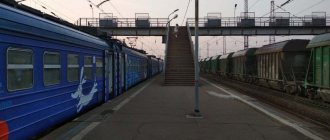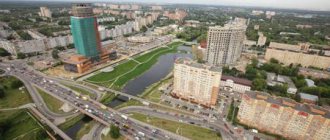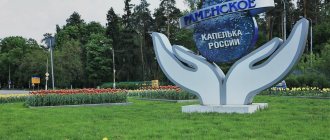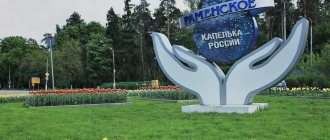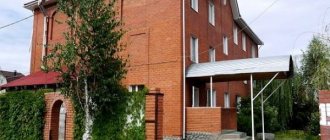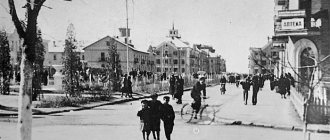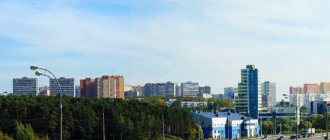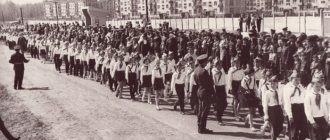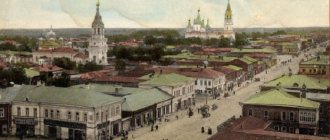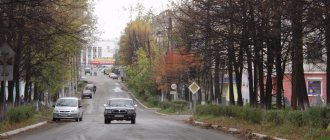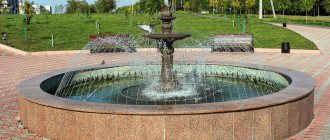This term has other meanings, see Dzerzhinsky (meanings).
| City Dzerzhinsky
| Coat of arms |
| A country | Russia, Russia |
| Subject of the federation | Moscow regionMoscow region |
| Urban district | Dzerzhinsky |
| Coordinates | 55°38′00″ n. w. 37°51′00″ E. long / 55.63333° north w. 37.85000° E. d. / 55.63333; 37.85000 (G) [www.openstreetmap.org/?mlat=55.63333&mlon=37.85000&zoom=12 (O)] (Z)Coordinates: 55°38′00″ N. w. 37°51′00″ E. long / 55.63333° north w. 37.85000° E. d. / 55.63333; 37.85000 (G) [www.openstreetmap.org/?mlat=55.63333&mlon=37.85000&zoom=12 (O)] (I) |
| Chapter | Panamorenko Vitaly Mikhailovich |
| First mention | 1380s |
| City with | 1981 |
| Square | 15.66[1]km² |
| Center height | 160 |
| Population | ↗53,867[2] people (2016) |
| Density | 3439.78 people/km² |
| Names of residents | Dzerzhintsy, Dzerzhinets |
| Timezone | UTC+3 |
| Telephone code | +7 495 |
| Postal codes | 140090, 140091, 140093 |
| Vehicle code | 50, 90, 150, 190, 750 |
| OKATO code | [classif.spb.ru/classificators/view/okt.php?st=A&kr=1&kod=46411 46 411] |
| Official site | [www.ugresh.ru/esh.ru] |
| Dzerzhinsky Moscow |
| Moscow Dzerzhinsky |
Audio, photo and video
on Wikimedia Commons
Dzerzhinsky
- a city of regional subordination in the Moscow region, southeast of Moscow, the only settlement of the municipal formation “Dzerzhinsky City District”.
Population - 53,867[2] people. (2016), area - 1566 hectares[1]. Dzerzhinsky is located on the Moscow River. It is a satellite city of Moscow, bordering it, separated from it by the Moscow Ring Road (MKAD). Dzerzhinsky also borders the cities of Kotelniki and Lytkarino. The nearest railway station is Lyubertsy-1, the distance to the city of Lyubertsy is four kilometers. In Dzerzhinsky there is a railway station (freight) without electrification from the Yanichkino station.
Story
The history of the city is closely connected with the Nikolo-Ugreshsky Monastery, which was founded by Dmitry Donskoy in 1380 in honor of the victory on the Kulikovo Field.
On the site of the current city were the villages of Alekseevka, Gremyachevo, Denisyevo and Kishkino[3].
In the 1920s, the monastery was closed, and within its walls a children's labor commune for street children was formed, which was called the Dzerzhinsky Commune. In 1938, the commune received the official status of an urban village.
The village was actively developing; in 1956, construction began on one of the largest combined heat and power plants in the country - CHPP-22. Modern multi-storey residential neighborhoods have grown up near the monastery walls on the site of the villages of Gremyachevo, Denisyevo and Kishkino[4].
In 1981, the working village of Dzerzhinsky received the status of a city of regional subordination as part of the Lyubertsy district of the Moscow region.
The first mayor of Dzerzhinsky, Viktor Ivanovich Dorkin, achieved the status of a city of regional subordination by September 4, 1996. Several times Dzerzhinsky was recognized as the most comfortable city in both the Moscow region and Russia.
On December 16, 2001, it was planned to hold a local referendum on the issue of giving the city a new name, Ugresha, but the referendum did not take place. On March 30, 2006, the head of the city, Viktor Dorkin, was shot dead with a Makarov pistol[5].
Governor of the Moscow region Andrei Vorobyov at the end of 2013 announced the decision to unite the urban districts “Kotelniki” and “Dzerzhinsky” into a newly formed urban district with the possible name “Ugresha”. K: Wikipedia: Articles without sources (type: not specified)[ source not 2905 days indicated
][6]
DZERZHINSKY CITY: ATTRACTIONS
In Dzerzhinsky, as in the whole country, the construction of four-story brick houses, the so-called “Khrushchevka”, was underway. In its historical part you can see a street of such houses, called Dzerzhinskaya Street.
In spring, the apple trees bloom so beautifully here, and there is such a scent, since the entire street is planted with apple trees. As in the song: “Apple trees in bloom are the creation of spring. Apple trees in bloom - love whirling.” But the city continues to grow and develop, and houses like this began to be built on modern streets.
Dzerzhinsky's calling card is the Nikolo-Ugreshsky Monastery
The Nikolo-Ugreshsky Monastery has become the calling card, the heart and soul of the city. Its revival began in 1990 after it was returned to the Russian Orthodox Church. There are 12 temples in the monastery, and after their reconstruction you can walk for hours and admire them.
The area is well-groomed, there is a beautiful pond. Both in summer and winter, black and white swans swim, a large number of ducks, and probably even more pigeons. Adults and children happily feed this army of birds.
The church shop has a large selection of crosses and icons. Herbal teas and other utensils are also sold. You can sit on benches, relax and admire the temples and landscape. It's beautiful and quiet here, so come, you won't regret it.
Monuments of the city of Dzerzhinsky
In honor of St. Nicholas the Wonderworker, protector of the Nikolo-Ugreshsky Monastery, a monument was erected behind the Palestine or Jerusalem Wall of the monastery. The sculpture of St. Nicholas the Wonderworker was made by V. Klykov.
For several centuries, Rus' was under the Tatar-Mongol yoke. The Tatars robbed the people, took women and children into captivity, and when Rus' became stronger, it decided to free itself from the hated yoke. According to legend, Grand Duke Dmitry Donskoy was blessed for this battle by the icon of St. Nicholas the Wonderworker.
The Nikolo-Ugreshsky Monastery is evidence that this legend is true. In honor of the founder of the Nikolo-Ugreshsky Monastery, a monument to Grand Duke Dmitry Donskoy was erected in the center of the city on the square named after the prince.
The “Eternal Flame” memorial in honor of those killed in the Second World War was installed in Victory Square. Next to the eternal flame there are 28 tombstones with the carved names of village residents who died in the Patriotic War. Of the several thousand who lived in the village, 700 soldiers died at that time, that is, the war brought grief to almost every family.
Residents of the city honor the memory of the fallen soldiers who defended us from the Nazi invaders at the cost of their lives, and there are always fresh flowers on the tombstones with names carved into the slabs.
The monument to the creators of the Russian missile shield is a complex of the legendary Katyusha, the Grad multiple launch rocket system and the Topol M ballistic missile.
These installations were created by numerous institutes, design bureaus and defense industry factories. A huge amount of work to create Russia’s missile shield was carried out by scientists, designers, engineers and workers of the Dzerzhinsky science city.
For this, many scientists, engineers and workers were awarded government orders and medals and State Prizes. Work to improve defense equipment continues at the present time at the Federal State Unitary Enterprise FSUE FTsDT “Soyuz”
The first mayor of the city of Dzerzhinsky, Viktor Dorkin, after graduating from the institute, got a job at the Scientific Research Institute of Chemical Technology, where he first worked as a simple engineer, and then reached the position of deputy head of the laboratory.
In 1990, he was elected chairman of the Dzerzhinsky City Council of People's Deputies, and in 1996, the people elected him mayor, and he led the city for 16 years. In 2006, late at night he left the building of a local television company, where, as usual, he answered questions from townspeople, and headed home; in the courtyard of the house, the killer shot him 16 times.
The killer and his partner were arrested and convicted. However, the customer managed to escape, and he was arrested only 10 years later upon his return to Russia. There is a monument to the first mayor of the city opposite the city hall.
Dzerzhinsky urban district
During the implementation of the Federal Law “On the General Principles of the Organization of Local Self-Government in the Russian Federation” (No. 131-FZ of October 6, 2003, entered into force on January 1, 2006), the system of municipalities was streamlined in the Moscow region. In 2004, the law of the Moscow Region “On granting the municipal formation “City of Dzerzhinsky of the Moscow Region” the status of an urban district ...” was adopted [21].
The Dzerzhinsky urban district includes one settlement - the city of Dzerzhinsky[21].
Geographical data
The area of the urban district is 1566 [1].
The municipality borders[21]:
- with the urban district of Kotelniki (in the north),
- with the urban settlement of Lyubertsy, Lyubertsy municipal district (in the northeast),
- with the urban district of Lytkarino (in the east),
- with the rural settlement of Molokovskoye, Leninsky municipal district (in the south),
- with the rural settlement of Razvilkovskoye, Leninsky municipal district (in the southwest),
- with the Kapotnya district of the SEAD of Moscow (in the west and north-west).
The Moscow River flows along the border of the urban district.
Authorities
The structure of local government bodies of the city is [22]:
- The Council of City Deputies
is an elected representative body of local self-government, which consists of 20 people elected according to a mixed system: 10 from party lists and 10 from single-mandate constituencies for a period of 5 years[23], - The head of the municipality
(
the head of the city
) is elected by the residents of the city for a period of 5 years [24], is also
the head of the administration
[24], - The city administration
is the executive and administrative body of local government[25], - Control body
- body of external financial control of the municipality[26], - The citywide meeting
is an advisory body whose participants are honorary citizens of the city, heads of enterprises, institutions and organizations, representatives of the city’s creative intelligentsia, deputies at various levels, and officials of the city administration[27].
The head of the city, the head of the administration is Vitaly Mikhailovich Panamorenko[28].
SPORTS AND RECREATION IN MY CITY DZERZHINSKY
There is a stadium here with two football fields, which in winter are used as a skating rink and then some people skate and others play hockey. The stadium has a whole range of sports equipment. There are various sports sections for adults and children. Olympic ski champion Nikita Kryukov grew up here.
The stadium has several closed buildings, where in the winter they practice basketball and tennis (children's sports school), and in the summer they play football on beautiful fields and hold matches with teams from other cities. Anyone can play basketball on the court or tennis on the adjacent field.
On the shore of the quarry there is the Freestyle ski center. There are two ski slopes, four lifts, and an illuminated track. Children can go down on cheesecakes. Adults here study with a ski instructor, and children take classes at a ski school. Snowmobiles and ATVs are available for rent. And there is a place to park vehicles, parking is free.
You can also visit a reindeer farm and ride Nordic dogs. Animals communicate friendly with people. You can go to the reindeer, they are allowed to feed and pet them. The guide shows the yurt, clothes and household items of the peoples of the north - all handmade.
Economy
The city-forming enterprises in Dzerzhinsky are:
- CHPP-22 - branch of Mosenergo;
- FCDT Soyuz is the main developer of solid rocket fuel in Russia;
- MKB "Horizon";
- Dzerzhinsky Industrial and Construction Branch of OJSC SPK Mosenergostroy; K: Wikipedia: Articles without sources (type: not specified) [ source not specified 3830 days
]
Also in Dzerzhinsky there are over 700 more institutions, enterprises and organizations of various forms of ownership. For example, the second car recycling plant in the Moscow region recently opened.
Other routing methods
Perhaps the simplest alternative is to open a road atlas and plot a route on the map by eye. Then, by rolling a curvimeter along the route, you can get the approximate mileage. Estimating travel time will be more difficult: to do this, you will have to divide the route into fragments with the same class of roads and measure the sum of the lengths of the fragments of each class. Further, knowing the average speed for each class of roads, it is easy to calculate the time by dividing the distance by the speed.
If you don’t have a curvimeter at hand, you can use a ruler. Place the zero mark of the ruler at the starting point of the route and move the ruler, tightly adjoining it to the curves of the road.
You can also calculate the distance between cities using tables that are published in atlases and reference books. This is quite convenient for routes starting and ending in large cities. Small settlements, as a rule, are not included in the tables.
Transport
See also: Dzerzhinsky bus
Pier on the river Moscow is operational and used by pleasure ships of the Capital Shipping Company, including from the Klenovy Boulevard pier (next to the Kolomenskaya metro station) to the pier in Dzerzhinsky - an excursion route to the Nikolo-Ugreshsky Monastery.
Within the city limits there is a former station and platform “Dzerzhinskaya”, the railway line from the station “Panki” - Dzerzhinskaya is now closed to passenger traffic. On September 21, 2015, the Kotelniki metro station on the Tagansko-Krasnopresnenskaya line opened a few kilometers from the city. In addition, by bus route No. 1063 of the Reis motor transport enterprise you can get to the Alma-Atinskaya metro station on the Zamoskvoretskaya line[29].
Dzerzhinsky today
Dzerzhinsky, located near Moscow, is still very young - it received city status in May 1981. But its history begins in the mists of time, when at the end of the fourteenth century the Moscow prince Dmitry Donskoy founded a monastic monastery in honor of St. Nicholas on the ancient Ugresha.
Dzerzhinsky is the closest neighbor of the Russian capital; the border between them runs along the Moscow Ring Road. A twenty-minute drive from the capital's Kuzminki metro station and you are greeted by a hospitable city, which is located in a forested park area of Moscow, occupying an area of 1,566 hectares. So, get acquainted...
Dzerzhinsky is a working city. Today, over 53 thousand residents (53,867 people) live here, more than 14 thousand of them are employed in various sectors of the city economy: science and energy, industry and construction, education and healthcare, trade and consumer services, culture and sports, social security and housing and communal services. In terms of production volume, it ranks fourth in the Moscow region, being a donor city.
The city-forming enterprises are the Federal State Unitary Enterprise Federal Center for Dual Technologies “Soyuz” and CHPP-22 of Mosenergo JSC. The city's construction complex is represented by the Dzerzhinsky reinforced concrete structures plant SPK Mosenergostroy, and the agro-industrial complex is represented by the joint-stock company Agro.
More than 1,000 small enterprises of various forms of ownership are registered in the city. Among the cities of the Moscow region with a population of up to 100 thousand inhabitants, Dzerzhinsky ranks first in terms of industrial production.
Dzerzhinsky is a science city where powerful scientific potential is concentrated. Many talented scientists grew up here, including an academician and two corresponding members of the Russian Academy of Sciences, eight members of industry academies, more than 40 doctors and 350 candidates of science. More than 20 percent of the population has higher education, which can be obtained directly in the city - four years ago, the Ugresha branch of the Dubna International University of Nature, Society and Humanity opened in Dzerzhinsky.
Dzerzhinsky is becoming more and more attractive and one of the most comfortable cities in the Moscow region, four times taking first place at the regional stage of the All-Russian competition “The most comfortable city in Russia” among cities in its category.
Dzerzhinsky is a twin city of Europe and Russia, including Turkish Marmaris, Bulgarian Montana and Berkovitsa, Spanish Elyana, Russian Ivanovo, Maloyaroslavets of the Kaluga region, Gubkin of the Belgorod region, Gus-Khrustalny of the Vladimir region, Soligalich of the Kostroma region, Zarechny Sverdlovsk region and Ozersky district of the Moscow region, as well as Aleksin, Tula region.
Dzerzhinsky is a warrior city, which has its own “armed forces” - sponsored military units where Dzerzhinsky guys serve. These are the 202nd anti-aircraft missile air defense brigade, the Geyser small missile ship, the 54th division of the strategic missile forces and the Military Academy of the General Staff of the Russian Armed Forces.
The city has many historical and cultural monuments. The most significant is the architectural ensemble of the St. Nicholas Ugreshsky stauropegial monastery, returned to the Russian Orthodox Church in 1990.
Dzerzhinsky is administratively independent, his administration and the Council of Deputies are aimed at developing partnerships with cities and enterprises, entrepreneurs and cultural figures.
We are open, ready and inviting to cooperation and joint solution of scientific, technical, environmental and social problems.
Information about the city of Dzerzhinsky, Moscow Region
The city of Dzerzhinsky is located in the south-eastern part of the central zone of the Moscow Region, in close proximity to the Moscow River. From the south its border is formed by the Moscow River, from the west the city of Dzerzhinsky borders on the city of Moscow, from the east the Tomilinsky Forest Park-nature reserve adjoins the city limits. From the north, a cascade of sand pits with ponds adjoins the city territory.
In ancient times, here, near the Moscow River, among the forests there was a road from Moscow to Ryazan.
There is a legend that in these places the first stop was made by the squad of the Grand Duke of Moscow - Dmitry Ivanovich, who spoke out in 1380 against the Tatar Khan Mamai. According to legend, at night the Grand Duke received a sign: the image of St. Nicholas the Wonderworker appeared before him. Delighted by the obvious manifestation of Divine grace, Dmitry, believing in victory, exclaimed: “This has sinned my heart!” (“This all warmed my heart!”). After the victory on the Kulikovo field, Prince Dmitry, at the site of the sign, “ordered to erect a temple in the name of St. Nicholas and establish a monastic monastery.” This is how the St. Nicholas Ugreshsky Monastery was founded.
The fate of the monastery is closely connected with the historical fate of all of Russia: its sorrows and joys, ups and downs. Standing on the close approaches to Moscow, the monastery has seen a lot in its lifetime: devastation during the era of the Tatar-Mongol yoke and during the era of impostors, the peasant war, schism and streltsy riots; during the Patriotic War of 1812, the monastery was occupied by the French. The monastery enjoyed the love of the supreme authorities, including the first Russian tsars from the Romanov dynasty, when Ugresha began to be called the “State pilgrimage.” But with the transfer of the capital to St. Petersburg, difficult times came for the monastery. And yet, having survived a long period of desolation (about 130 years), the monastery is being reborn again. This revival is associated with the name of the outstanding church figure Archimandrite Pimen (Petr Dmitrievich Myasnikov), when the modern appearance of the monastery took shape, with the grandiose Transfiguration Cathedral, erected in honor of the 500th anniversary of the Battle of Kulikovo.
The coming twentieth century brought new changes to the life of the monastery. In 1921, the children's colony MONO found shelter in Ugresh and the monastery changed its name. Now it is a red children's corner. Later, in 1926, the OGPU organized labor commune No. 2, later the Dzerzhinsky labor commune, the story of which formed the basis of the film “A Start to Life” (dir. N. Ecker, 1931). With the development of the commune, a musical instrument factory, a fiberboard factory, an electrical factory, and a kitchen factory appeared here. Ugresha takes on an industrial appearance and a village grows up near the monastery, which in 1938 receives the status of an independent administrative unit and is named after F.E. Dzerzhinsky. By this time it was one of the largest settlements in the Ukhtomsky region. There are several industrial enterprises in the village, employing more than 5 thousand people. The population reached 9 thousand people. The commune ceases to exist.
At the beginning of the Great Patriotic War, on the basis of the Spartak plant, Plant 512 of the People's Commissariat of Ammunition was created, producing charges for Katyushas. In 1943, a Special Bureau was organized at the plant, where imprisoned engineers and scientists worked. In the post-war years, the Soyuz association was created on the basis of the plant and bureau for the development and production of rocket fuels.
In 1955, the construction of CHPP-22 and the enterprises providing construction began - DZZHBK, SU CHPP-22, and together with them - the construction of a new residential microdistrict of the village.
So in the village of Dzerzhinsky in the mid-60s, two centers appeared, around which the formation of the communal infrastructure of the future city took place - LNPO Soyuz and CHPP-22. Thanks to these two large enterprises, the village is developing and growing.
In the post-war years, other scientific and industrial enterprises of union and republican significance were also created and developed in the village of Dzerzhinsky: OKB “Gorizont”, engineering center “Welding”, “Tsentrgazoochistka” and others.
In May 1981, by Decree of the Presidium of the Supreme Soviet of the RSFSR, the village of Dzerzhinsky was transformed into a city of regional significance.
The city emerged as a science city of the military-industrial complex. It was formed mainly under the influence and influence of the FCDT “Union”, founded in 1947. and the largest enterprise in the city, CHPP-22.
In 2000 In terms of industrial output, it took fourth place among 29 cities in the Moscow region, being a donor city.
The city-forming enterprise of the city, FCDT Soyuz, is characterized by a high level of scientific and engineering solutions, which allows it to successfully solve problems in creating rocket and space products. The company is actively developing dual-use technologies, and has launched the production of conversion products: systems and means of aerosol and liquid fire extinguishing, fireworks compositions, means for reviving oil and gas wells, emergency shutdown and repair of oil and gas pipelines, synthetic detonation diamonds; polymer magnetic materials; installations and ceramic masses for “hot” repair of fire-resistant coatings; road marking equipment and materials; drugs based on nitroglycerin; paints and varnishes, adhesives and pigments; wastewater treatment technology. The company's developments have been awarded with more than 1,000 diplomas and medals from VDNKh, medals from international exhibitions and the World Salons of Inventions.
The second city-forming enterprise of the city, CHPP-22 of Mosenergo JSC, is the largest in Europe and the world in terms of the total volume of heat and electricity produced. It provides heat and electricity to over 1.5 million people and over 150 enterprises in Moscow and the Moscow region. In 1997 Electric precipitators were put into operation, which made it possible to increase the degree of combustion purification from 95% to 99.8%. The emission of suspended substances into the atmosphere decreased by 4.5 times. In 2000 A significant amount of work was completed related to the reconstruction of the 7th turbine, which was launched on February 26, 2001. This is the launch of the first turbine in Russia in the 21st century.
The history of the Nikolo-Ugreshsky Monastery during the years of socialism was typical and very sad: devastation and desolation reigned here. The changes taking place in recent years have restored the broken connection of times. In December 1990, the Nikolo-Ugreshsky Monastery was returned to the Russian Orthodox Church and received stauropegial status, i.e. under patriarchal control. The first monks appeared in the monastery. Archimandrite Veniamin (Zaritsky) was appointed vicar of the monastery. The restoration of the monastery began.
Since 1990, a new stage in the development of the city begins. The Nikolo-Ugreshsky Monastery is being revived, and the activities of the city administration are intensifying. Being in close proximity to Moscow, the city is influenced by socio-economic and economic-functional processes in it. Having a developed complex of scientific, industrial and agricultural enterprises, and having a sufficient tax base, the city has the opportunity to independently solve all local problems and maintain the city infrastructure. The city is reaching a new level of development, surpassing the regional average in a number of indicators. At the same time, a whole complex of problems arises, the solution of which is only possible with greater independence. The city of Dzerzhinsky, administratively part of the Lyubertsy district, begins a struggle to secede from the district and give the city the status of regional significance.
On December 17, 1995, at a city referendum, the Charter of the city of Dzerzhinsky was adopted as an independent municipal entity, not part of other entities. Eighty-three percent of voters voted in favor of the city charter.
On February 24, 1996, the first popular elections in the history of the city for the mayor and 12 deputies of the City Duma took place.
By decision of the Moscow Regional Duma No. 11/99 of September 4, 1996, the city of Dzerzhinsky was given the status of a city of regional significance.
Where is it located
Deviation from Moscow time, hours: 0 Geographic latitude: 55°38′ Geographic longitude: 37°51′
The city of Dzerzhinsky is an independent municipal entity within the Moscow region and is not included in other municipal entities.
The city is located on the border of the city of Moscow and is located outside the MKAD (Moscow Ring Road). The nearest metro stations “Kuzminki” and “Lublino” are the South-Eastern district of Moscow. — microdistrict — Kapotnya Turn into the city from the Moscow Ring Road following the “Dzerzhinsky” sign. The turn point to the Moscow Ring Road is 16 kilometers. Landmarks are the pipes of TPP-22 on the outer side of the Moscow Ring Road. How to get there
Traffic routes
Where to write
City postal codes: 140090 140091 140093
How to call
Telephone numbering is in the seven-digit zone. Telephone numbers from which the telephone numbers of individuals and organizations located in the city begin: 550 - any numbers 551 - any numbers 505-81 - any numbers
To call our city by long-distance telephone, you need to dial the Moscow code (495) and the city seven-digit telephone number.
(495) city phone number
To call our city internationally, you need to dial the country code - Russia - +7 Moscow code (495) and a seven-digit city telephone number.
+7 (495) city phone number
Communications and media
The following operators provide communication services in the city:
- "Virgin Connect" (formerly LLC "Darling-TIN")
- "Ugresha Network"
- LLC "Dzinet"
- LLC "AVK-WELLCOM"
- JSC "Montazh"
- NP “Communication Without Borders” (since 2010 merged with “Ugresha Network”)
- R.I.M.S.
- Eurasia Telecom Ru
- Rostelecom
Cable television "Ugresha". Since January 1991, the newspaper “Ugreshskie Vesti” has been published.
Mobile operators:
- Beeline;
- Megaphone;
- MTS;
- Sky Link.
- TELE2
Twin Cities
Below is a list of sister cities of Dzerzhinsky[30]:
abroad -
- Berkovitsa, Bulgaria
- Marmaris, Türkiye
- Montana, Bulgaria
- Ellana, Spain
in Russia and in the countries of the Near Abroad -
- Aleksin, Russia
- Belomorsk, Russia
- Gubkin, Russia
- Gus-Khrustalny, Russia
- Zarechny, Russia
- Znamensk, Russia
- Ivanovo, Russia
- Maloyaroslavets, Russia
- Ozyory, Russia
- Soligalich, Russia
- Kharabali, Russia
- / Krasnoperekopsk[31], Russia/Ukraine[32]
Links
| External links in this article may not comply with Wikipedia guidelines. You can improve this article by removing unnecessary or inappropriate links. |
Areas: Dmitry Donskoy • St. Nicholas Other streets: Alekseevskaya • Bondareva • Denisyevsky proezd • Zavodskaya • Zelenaya • ZIL Quarry • Lazurina Boulevard • Lermontov • Ovinovka • Poklonnaya • Pushkin proezd • Sadovaya • Severny proezd • Stroiteley • Stroygorodok • Trudkommuny • Shama • Shkolnaya • Energetikov • Yuzhny proezd Moscow region Urban districts Balashikha • Bronnitsy • Vlasikha (ZATO) • Voskhod (ZATO) • Dzerzhinsky • Dolgoprudny • Domodedovo • Dubna • Yegoryevsk • Zhukovsky • Zvenigorod • Star City (ZATO) • Ivanteevka • Kashira • Kolomna • Korolev • Kotelniki • Krasnoarmeysk • Krasnoznamensk (ZATO) • Lobnya • Losino-Petrovsky • Lytkarino • Molodezhny (ZATO) • Mytishchi • Ozyory • Orekhovo-Zuevo • Podolsk • Protvino • Pushchino • Reutov • Roshal • Serebryanye Prudy • Serpukhov • Fryazino • Khimki • Chernogolovka • Elektrogorsk • Elektrostal • Shakhovskaya
An excerpt characterizing Dzerzhinsky (city)
And Prince Andrei, having given the order to leave, went to his room. “You know what, my dear,” said Bilibin, entering his room. - I thought about you. Why are you going? And to prove the irrefutability of this argument, all the folds disappeared from the face. Prince Andrei looked questioningly at his interlocutor and did not answer. - Why are you going? I know you think it is your duty to join the army now that the army is in danger. I understand that, mon cher, c'est de l'heroisme. [my dear, this is heroism.] “Not at all,” said Prince Andrei. - But you are un philoSophiee, [a philosopher,] be one completely, look at things from the other side, and you will see that your duty, on the contrary, is to take care of yourself. Leave it to others who are no longer fit for anything... You were not ordered to come back, and you were not released from here; therefore, you can stay and go with us, wherever our unfortunate fate takes us. They say they are going to Olmutz. And Olmutz is a very nice city. And you and I will ride together calmly in my stroller. “Stop joking, Bilibin,” said Bolkonsky. – I tell you sincerely and in a friendly manner. Judge. Where and why will you go now that you can stay here? One of two things awaits you (he gathered the skin above his left temple): either you don’t reach the army and peace will be concluded, or defeat and disgrace with the entire Kutuzov army. And Bilibin loosened his skin, feeling that his dilemma was irrefutable. “I can’t judge this,” Prince Andrei said coldly, but he thought: “I’m going in order to save the army.” “Mon cher, vous etes un heros, [My dear, you are a hero,” said Bilibin. That same night, having bowed to the Minister of War, Bolkonsky went to the army, not knowing where he would find it, and fearing on the way to Krems to be intercepted by the French. In Brünn, the entire court population packed up, and the burdens were already sent to Olmütz. Near Etzelsdorf, Prince Andrei drove out onto the road along which the Russian army was moving with the greatest haste and in the greatest disorder. The road was so crowded with carts that it was impossible to travel in a carriage. Having taken a horse and a Cossack from the Cossack commander, Prince Andrei, hungry and tired, overtaking the carts, rode to find the commander-in-chief and his cart. The most ominous rumors about the position of the army reached him on the way, and the sight of the army randomly running confirmed these rumors. "Cette armee russe que l'or de l'Angleterre a transportee, des extremites de l'univers, nous allons lui faire eprouver le meme sort (le sort de l'armee d'Ulm)", ["This Russian army, which English gold was brought here from the end of the world, will experience the same fate (the fate of the Ulm army).”] he recalled the words of Bonaparte’s order to his army before the start of the campaign, and these words equally aroused in him surprise at the brilliant hero, a feeling of offended pride and hope of glory. “What if there is nothing left but to die? he thought. Well, if necessary! I will do it no worse than anyone else.” Prince Andrei looked with contempt at these endless, interfering teams, carts, parks, artillery and again carts, carts and carts of all possible types, overtaking one another and clogging the dirt road in three or four rows. From all sides, behind and in front, as long as one could hear one could hear the sounds of wheels, the rumble of bodies, carts and carriages, the clatter of horses, blows of a whip, shouts of urging, curses of soldiers, orderlies and officers. Along the edges of the road one could constantly see either fallen, skinned and unkempt horses, or broken carts, near which lonely soldiers were sitting, waiting for something, or soldiers separated from their teams, who were heading in crowds to neighboring villages or dragging chickens, sheep, hay or hay from the villages. bags filled with something. On the descents and ascents the crowds became thicker, and there was a continuous groan of shouts. The soldiers, sinking knee-deep in mud, picked up guns and wagons in their hands; whips beat, hooves slid, lines burst and chests burst with screams. The officers in charge of the movement drove forward and backward between the convoys. Their voices were faintly audible amid the general roar, and it was clear from their faces that they despaired of being able to stop this disorder. “Voila le cher [“Here is the dear] Orthodox army,” thought Bolkonsky, remembering the words of Bilibin. Wanting to ask one of these people where the commander-in-chief was, he drove up to the convoy. Directly opposite him was riding a strange, one-horse carriage, apparently constructed at home by soldiers, representing a middle ground between a cart, a convertible and a carriage. The carriage was driven by a soldier and sat under a leather top behind an apron, a woman, all tied with scarves. Prince Andrei arrived and had already addressed the soldier with a question when his attention was drawn to the desperate cries of a woman sitting in a tent. The officer in charge of the convoy beat the soldier, who was sitting as a coachman in this carriage, because he wanted to go around others, and the whip hit the apron of the carriage. The woman screamed shrilly. Seeing Prince Andrei, she leaned out from under her apron and, waving her thin arms that had jumped out from under the carpet scarf, shouted: “Adjutant!” Mr. Adjutant!... For God's sake... protect... What will this happen?... I am the doctor's wife of the 7th Jaeger... they won't let me in; We fell behind, we lost our own... - I’ll break you in a cake, wrap it up! - the embittered officer shouted at the soldier, - turn back with your whore. - Mr. Adjutant, protect me. What is this? – the doctor shouted. - Please let this cart pass. Can't you see that this is a woman? - said Prince Andrei, driving up to the officer. The officer looked at him and, without answering, turned back to the soldier: “I’ll go around them... Back!...” “Let me through, I’m telling you,” Prince Andrei repeated again, pursing his lips. - And who are you? - the officer suddenly turned to him with drunken fury. - Who are you? You (he especially emphasized on you) are the boss, or what? I'm the boss here, not you. “You go back,” he repeated, “I’ll smash you into a piece of cake.” The officer apparently liked this expression. “He shaved the adjutant seriously,” a voice was heard from behind. Prince Andrei saw that the officer was in that drunken fit of causeless rage in which people do not remember what they say. He saw that his intercession for the doctor’s wife in the wagon was filled with what he feared most in the world, what is called ridicule [ridiculous], but his instinct said something else. Before the officer had time to finish his last words, Prince Andrei, with a face disfigured from rage, rode up to him and raised his whip: “Please let me in!” The officer waved his hand and hurriedly drove away. “It’s all from them, from the staff, it’s all a mess,” he grumbled. - Do as you please. Prince Andrei hastily, without raising his eyes, rode away from the doctor's wife, who called him a savior, and, recalling with disgust the smallest details of this humiliating scene, galloped further to the village where, as he was told, the commander-in-chief was located. Having entered the village, he got off his horse and went to the first house with the intention of resting at least for a minute, eating something and bringing into clarity all these offensive thoughts that tormented him. “This is a crowd of scoundrels, not an army,” he thought, approaching the window of the first house, when a familiar voice called him by name. He looked back. Nesvitsky’s handsome face poked out from a small window. Nesvitsky, chewing something with his juicy mouth and waving his arms, called him to him. - Bolkonsky, Bolkonsky! Don't you hear, or what? “Go quickly,” he shouted. Entering the house, Prince Andrei saw Nesvitsky and another adjutant eating something. They hastily turned to Bolkonsky asking if he knew anything new. On their faces, so familiar to him, Prince Andrei read an expression of anxiety and concern. This expression was especially noticeable on Nesvitsky’s always laughing face. -Where is the commander-in-chief? – asked Bolkonsky. “Here, in that house,” answered the adjutant. - Well, is it true that there is peace and surrender? – asked Nesvitsky. - I'm asking you. I don’t know anything except that I got to you by force. - What about us, brother? Horror! “I’m sorry, brother, they laughed at Mak, but it’s even worse for us,” Nesvitsky said. - Well, sit down and eat something. “Now, prince, you won’t find any carts or anything, and your Peter, God knows where,” said another adjutant. -Where is the main apartment? – We’ll spend the night in Tsnaim. “And I loaded everything I needed onto two horses,” said Nesvitsky, “and they made me excellent packs.” At least escape through the Bohemian mountains. It's bad, brother. Are you really unwell, why are you shuddering like that? - Nesvitsky asked, noticing how Prince Andrei twitched, as if from touching a Leyden jar. “Nothing,” answered Prince Andrei. At that moment he remembered his recent clash with the doctor’s wife and the Furshtat officer. -What is the commander-in-chief doing here? - he asked. “I don’t understand anything,” said Nesvitsky. “All I understand is that everything is disgusting, disgusting and disgusting,” said Prince Andrei and went to the house where the commander-in-chief stood. Passing by Kutuzov's carriage, the tortured horses of the retinue and the Cossacks speaking loudly among themselves, Prince Andrei entered the entryway. Kutuzov himself, as Prince Andrei was told, was in the hut with Prince Bagration and Weyrother. Weyrother was an Austrian general who replaced the murdered Schmit. In the entryway little Kozlovsky was squatting in front of the clerk. The clerk on an inverted tub, turning up the cuffs of his uniform, hastily wrote. Kozlovsky’s face was exhausted - he, apparently, had not slept at night either. He looked at Prince Andrei and did not even nod his head to him. – Second line... Did you write it? - he continued, dictating to the clerk, - Kiev Grenadier, Podolsk... - You won’t have time, your honor, - the clerk answered disrespectfully and angrily, looking back at Kozlovsky. At that time, Kutuzov’s animatedly dissatisfied voice was heard from behind the door, interrupted by another, unfamiliar voice. By the sound of these voices, by the inattention with which Kozlovsky looked at him, by the irreverence of the exhausted clerk, by the fact that the clerk and Kozlovsky were sitting so close to the commander-in-chief on the floor near the tub, and by the fact that the Cossacks holding the horses laughed loudly under window of the house - from all this, Prince Andrei felt that something important and unfortunate was about to happen. Prince Andrei urgently turned to Kozlovsky with questions. “Now, prince,” said Kozlovsky. – Disposition to Bagration. -What about capitulation? - There is none; orders for battle have been made. Prince Andrei headed towards the door from behind which voices were heard. But just as he wanted to open the door, the voices in the room fell silent, the door opened of its own accord, and Kutuzov, with his aquiline nose on his plump face, appeared on the threshold. Prince Andrei stood directly opposite Kutuzov; but from the expression of the commander-in-chief’s only seeing eye it was clear that thought and concern occupied him so much that it seemed to obscure his vision. He looked directly at the face of his adjutant and did not recognize him. - Well, have you finished? – he turned to Kozlovsky. - Right this second, Your Excellency. Bagration, a short man with an oriental type of firm and motionless face, a dry, not yet old man, followed the commander-in-chief. “I have the honor to appear,” Prince Andrei repeated quite loudly, handing over the envelope. - Oh, from Vienna? Fine. After, after! Kutuzov went out with Bagration onto the porch. “Well, prince, goodbye,” he said to Bagration. - Christ is with you. I bless you for this great feat. Kutuzov's face suddenly softened, and tears appeared in his eyes. He pulled Bagration to him with his left hand, and with his right hand, on which there was a ring, apparently crossed him with a familiar gesture and offered him a plump cheek, instead of which Bagration kissed him on the neck. - Christ is with you! – Kutuzov repeated and walked up to the carriage. “Sit down with me,” he said to Bolkonsky. – Your Excellency, I would like to be useful here. Let me stay in the detachment of Prince Bagration. “Sit down,” said Kutuzov and, noticing that Bolkonsky was hesitating, “I need good officers myself, I need them myself.” They got into the carriage and drove in silence for several minutes. “There is still a lot ahead, there will be a lot of things,” he said with an senile expression of insight, as if he understood everything that was happening in Bolkonsky’s soul. “If one tenth of his detachment comes tomorrow, I will thank God,” added Kutuzov, as if speaking to himself. Prince Andrei looked at Kutuzov, and he involuntarily caught his eye, half an arshin away from him, the cleanly washed assemblies of the scar on Kutuzov’s temple, where the Izmail bullet pierced his head, and his leaking eye. “Yes, he has the right to talk so calmly about the death of these people!” thought Bolkonsky. “That’s why I ask you to send me to this detachment,” he said. Kutuzov did not answer. He seemed to have already forgotten what he had said and sat thoughtful. Five minutes later, smoothly rocking on the soft springs of the stroller, Kutuzov turned to Prince Andrei. There was no trace of excitement on his face. With subtle mockery, he asked Prince Andrei about the details of his meeting with the emperor, about the reviews he had heard at court about the Kremlin affair, and about some common women he knew. Kutuzov, through his spy, received news on November 1 that put the army he commanded in an almost hopeless situation. The scout reported that the French in huge numbers, having crossed the Vienna bridge, headed towards Kutuzov’s route of communication with the troops coming from Russia. If Kutuzov had decided to stay in Krems, then Napoleon’s army of one and a half thousand would have cut him off from all communications, surrounded his exhausted army of forty thousand, and he would have been in Mack’s position near Ulm. If Kutuzov had decided to leave the road that led to communications with troops from Russia, then he would have had to enter without a road into the unknown lands of the Bohemian
